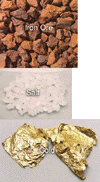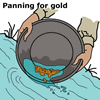|
Refining metals
 Metals
are found in many different forms from gold and platinum as pure native
metals, through mercury as metal drops in red cinnabar ore, to iron in
mountains of iron oxide rust and lithium and sodium as salts in seawater. Metals
are found in many different forms from gold and platinum as pure native
metals, through mercury as metal drops in red cinnabar ore, to iron in
mountains of iron oxide rust and lithium and sodium as salts in seawater.
Reactivity and form
The form a metal takes in the natural world is dependent on its reactivity
with water and air. The inert or unreactive metals like gold and platinum
are found as native metals. More reactive metals like mercury and copper
can be found as both native metals and as compounds in ores. While the
most reactive metals are never found in the metal form, but always as
compounds in rock ore or in sea water.
This table shows the reactivity of some common metals, including a section
showing how each metal is normally found in nature.
|
Li
|
K
|
Ca
|
Na
|
Mg
|
Al
|
Zn
|
Fe
|
Pb
|
Cu
|
Hg
|
Ag
|
Au
|
Pt
|
|
React with water
|
React with acid
|
Do not react with acid or water
|
|
Burn in air
|
Corrode quickly
|
Tarnish in air
|
Do not react
|
|
salts/seawater
|
salts and rock ore
|
rock ore and metal
|
native metal
|
|
Extraction of a metal from its ore
The more reactive a metal is (i.e. Li, K and Ca) the more difficult it
is to extract the metal from its ore or salt.
Although methods of production will vary from one metal to another,
depending on their individual relativities and physical properties, the
extraction of metals can be divided into four main types:
- The moderate to highly reactive metals, from Li to Zn, are obtained
by electrolysis of a salt containing the respective metal. This involves
melting the pure salt at high temperature in a large electric cell and
passing an electric current through the molten salt. The metal is collected
at one electrode and the other elements in the salt collected at the
other. See the topic Production
of aluminium for more on electrolysis.
The production of sodium metal from salt is demonstrated in the following
animation.
- The less reactive metals, from Fe to Cu on the above table, typically
are produced by reduction of the ore in a blast furnace with carbon.
This involves mixing the crushed ore, usually metal oxides and sulphides,
with coal or coke. Lime is added to remove waste material and the whole
lot is heated together. See the topic Production
of iron for more on this process. The blast furnace animation shows
this process in action.
- Mercury and silver are either obtained as native metals or by heating
their ores releasing the metal from the ore. In the case of mercury
this is a very simple process involving heating cinnabar (red mercury
sulphide) and collecting the mercury vapours. This is demonstrated in
the following animation.
-
 Gold and platinum are usually either found as pure native metals
or are extracted by separating the metal from their surrounding rock
by crushing and dissolving the metal out with strong acids and cyanide
solutions. The river pollution from the Ok Tedi mine in Papua New Guinea
in 2000 clearly shows the problems associated with this type of mining
and extraction process.
Gold and platinum are usually either found as pure native metals
or are extracted by separating the metal from their surrounding rock
by crushing and dissolving the metal out with strong acids and cyanide
solutions. The river pollution from the Ok Tedi mine in Papua New Guinea
in 2000 clearly shows the problems associated with this type of mining
and extraction process.
|
|
 Metals
are found in many different forms from gold and platinum as pure native
metals, through mercury as metal drops in red cinnabar ore, to iron in
mountains of iron oxide rust and lithium and sodium as salts in seawater.
Metals
are found in many different forms from gold and platinum as pure native
metals, through mercury as metal drops in red cinnabar ore, to iron in
mountains of iron oxide rust and lithium and sodium as salts in seawater.

 Gold and platinum are usually either found as pure native metals
or are extracted by separating the metal from their surrounding rock
by crushing and dissolving the metal out with strong acids and cyanide
solutions. The river pollution from the Ok Tedi mine in Papua New Guinea
in 2000 clearly shows the problems associated with this type of mining
and extraction process.
Gold and platinum are usually either found as pure native metals
or are extracted by separating the metal from their surrounding rock
by crushing and dissolving the metal out with strong acids and cyanide
solutions. The river pollution from the Ok Tedi mine in Papua New Guinea
in 2000 clearly shows the problems associated with this type of mining
and extraction process. 